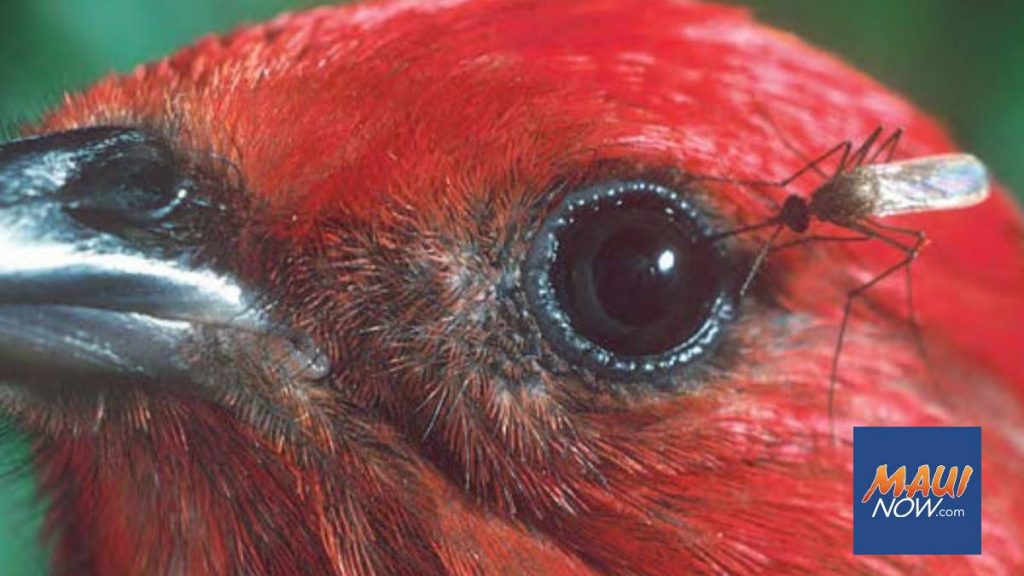East Maui project hopes mosquito v. mosquito mating battle will save endangered birds

In the latest effort to protect endangered forest birds in East Maui, state and federal officials are gearing up for a mosquito versus mosquito mating mission.
If successful, the project would cut the non-native wild mosquito population by 90%, according to an environmental study released last week. These mosquitos are the only insects that spur avian malaria, which threatens and kills important East Maui forest birds.
The National Park Service and state Department of Land and Natural Resources are proposing to release lab-raised incompatible male mosquitoes via drones to the existing wild population. If the incompatible male and the wild female mate, the two are unproductive and populations will be suppressed, leading to fewer cases of avian malaria and other mosquito-related diseases that impact birds.
The approach employs the incompatible insect technique (IIT), which uses a naturally occurring bacteria called Wolbachia that’s already present in many insect species on Maui. IIT has been successfully implemented in other parts of the US and the world, according to a draft environmental assessment published Thursday in the state Office of Planning and Sustainable Development’s “The Environmental Notice.”
Now, a 30-day public review and comment period starts with comments due by Jan. 9, 2023, via the National Park Service project page.
When male mosquitoes with an incompatible strain of Wolbachia are introduced to a population of female mosquitoes, reproduction is blocked. If releases are done repeatedly over time, they further suppress the mosquito population.
The project is no small feat, though. About 75% of more than 48,000 acres in East Maui would have to be treated via nearly 1,400 release locations.
Incompatible males would need to outcompete wild males, so it’s important to “overflood” the wild males with the incompatible ones, the study said.
“Based on current estimates, we expect to release between 50 and 6,000 incompatible mosquitoes per acre per treatment (which would occur up to twice per week) depending on elevation and local temperature and capture data gathered during monitoring,” the study said.
Efficacy would also depend on numbers and availability of lab-reared southern house mosquitoes that carry incompatible strains of Wolbachia. At first, on-the-ground or aerial releases of incompatible mosquitoes would allow field teams to monitor effectiveness of IIT. If it’s successful, the project would deploy drones to release mosquitoes.

The effort is the latest work to save endangered Hawaiian forest birds. Two types, kiwikiu and ʻākohekohe, have decreased by more than 70% over the last 20 years, and population projections predict extinction in the next two to 10 years, the study said.
In the past, conservation experts tried to relocate East Maui kiwikiu to higher elevations along Haleakalā with fewer mosquitoes. But the time-consuming project was unsuccessful.
The draft environmental assessment did not include an estimated timeline for the project to begin or a possible cost. The proposed use of state or county lands or state or county funds, along with the use of conservation lands, trigger a state-mandated environmental study.
In response to comments received during public scoping, the following are key points on the project, according to the draft environmental assessment:
- Male mosquitoes do not bite animals or humans. This project would only release male mosquitoes.
- Wolbachia is already present in many insects in Hawaiʻi, including the southern house mosquito populations present on Maui. This project would release only male mosquitoes with a different strain of Wolbachia bacteria to that occurring in southern house mosquitoes in East Maui.
- Wolbachia bacteria cannot transfer between animal species or to humans. Similarly, it cannot transfer between male mosquitoes and female mosquitoes; mosquitoes can only inherit Wolbachia from their mother.
- The southern house mosquito, like all mosquitoes in Hawaiʻi, is an invasive species on Maui. It occupies higher elevations and cooler environments than other species of mosquitoes found on Maui. Other mosquito species would not expand their ranges in response to elimination of southern house mosquitoes.
- Southern house mosquitoes are not an important source of food for native bats, birds, or other insects in Hawaiʻi.
- Neither southern house mosquitoes nor Wolbachia bacteria are new organisms to Maui; this project would not result in introduction of any new species to the island.
- The proposed use of IIT does not include genetic engineering techniques which result in genetically modified organisms (GMOs).








